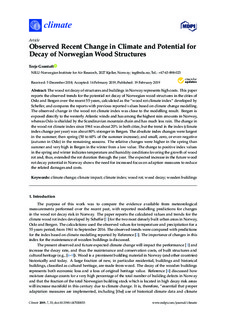| dc.description.abstract | The wood rot decay of structures and buildings in Norway represents high costs. This paper reports the observed trends for the potential rot decay of Norwegian wood structures in the cities of Oslo and Bergen over the recent 55 years, calculated as the “wood rot climate index” developed by Scheffer, and compares the reports with previous reported values based on climate change modelling. The observed change in the wood rot climate index was close to the modelling result. Bergen is exposed directly to the westerly Atlantic winds and has among the highest rain amounts in Norway, whereas Oslo is shielded by the Scandinavian mountain chain and has much less rain. The change in the wood rot climate index since 1961 was about 20% in both cities, but the trend in the index (climate index change per year) was about 80% stronger in Bergen. The absolute index changes were largest in the summer; then spring (50 to 60% of the summer increase); and small, zero, or even negative (autumn in Oslo) in the remaining seasons. The relative changes were higher in the spring than summer and very high in Bergen in the winter from a low value. The change to positive index values in the spring and winter indicates temperature and humidity conditions favoring the growth of wood rot and, thus, extended the rot duration through the year. The expected increase in the future wood rot decay potential in Norway shows the need for increased focus on adaption measures to reduce the related damages and costs. | nb_NO |

